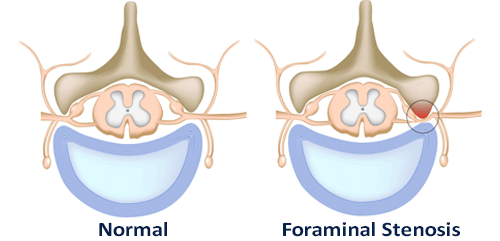Foraminal Narrowing Causes
Foraminal narrowing occurs in the foramina, which are the openings between the vertebrae where the nerve root branches out of the spinal cord. When foraminal narrowing occurs, the space available for the nerve roots becomes restricted.
There are many different factors and causes associated with foraminal narrowing or foraminal stenosis. However, as with many spinal conditions, the most common cause is natural degeneration of the spine due to age and wear and tear.
Foraminal Narrowing Risk Factors
Since foraminal narrowing can arise from wear and tear, certain risk factors play a significant role in the development of this condition, including:
- Genetics – Some people are born with this condition
- Age – With age, the spinal cord starts to weaken and become narrower
- Activity – Repetitive movements can lead to this condition
- Weight – Overweight individuals are more prone to premature wear and tear on the spine
Degenerative Spine Conditions
Foraminal narrowing is essentially the narrowing of the foramina. Certain degenerative spine conditions can cause this condition. Degenerative spine conditions are the most common cause of foraminal narrowing.
Certain degenerative spine conditions that lead to spine abnormalities can lead to the narrowing of the foramina and cause foraminal stenosis. Some of these circumstances include:
- Facet syndrome
- Spondylolisthesis
- Degenerative disc disease
- Spinal arthritis
- Loss of disc height due to degenerative disc disease
Spine Conditions That Cause Foraminal Narrowing
Individual conditions that press directly into the foraminal canal, can cause nerve compression or pinching. With age, the foraminal canal is susceptible to narrowing in specific sections of the spine as it misaligns and moves into the unfilled canal space. This change in alignment is often due to constant repetitive movement, as well as inflicted by certain spinal conditions.
These spinal conditions arise with age as the spine begins to weaken over time. These conditions may include:
- Herniated disc
- Bulging disc
- Bone spurs
- Collapsed discs
- Loss of vertebral stability due to facet disease
- Trauma and sudden injury

